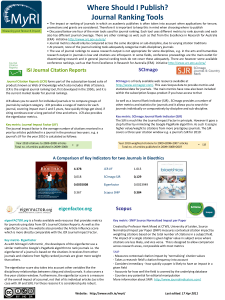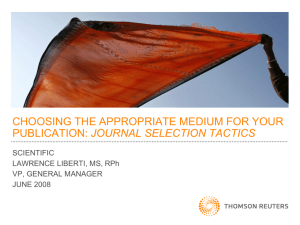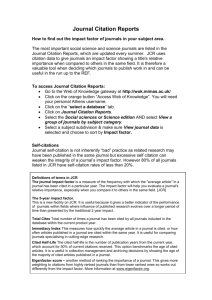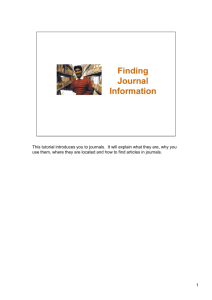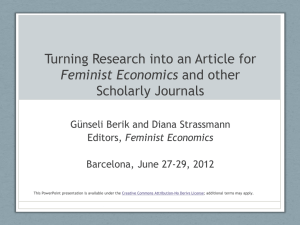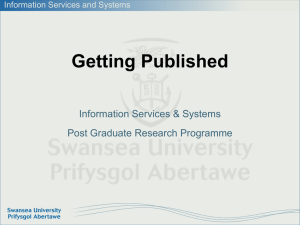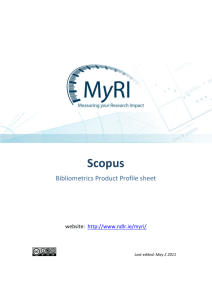Presentation Slides
advertisement
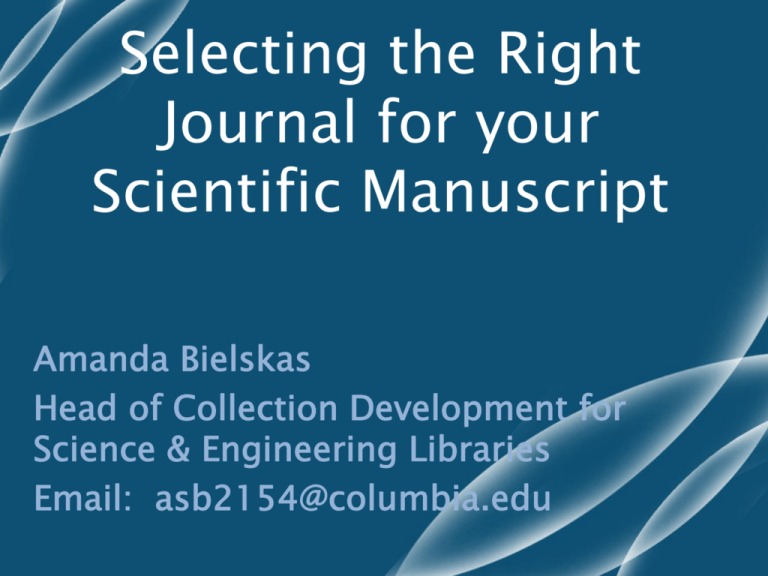
Selecting the Right Journal for your Scientific Manuscript How many journals... …are out there to publish in? …does Columbia have access to? Finding the right journal in which to publish your article can be a difficult process. Selecting the Right Journal for your Scientific Manuscript Outline: • • • • Criteria to consider Impact Factor & other metrics Open access journals Tools: help identify journals to publish in Criteria to consider: Journal information/Content • Journals used by yourself/ mentors/advisor/colleagues • Types of articles published (original research, review, case study) • Length of manuscript accepted • Supplemental data Criteria to consider: Reputation of the journal • # years in publication • Cost and availability (journal cost effectiveness) • Open access • Peer review status • Impact factor Criteria to consider: Reputation of the journal • Reputation of the journal (publisher, editor) • Acceptance/rejection rates (journals with lower acceptance rates are generally more prestigious) • Quality of accepted articles and authors • Audience of journal (readership) • Audience Size (indexing & circulation) Criteria to consider Review Process • Time to publication (speed of peer review, pre-pub online) • Publication Costs & Author Fees: (should fall in the industry standard $1500 $5000 range) : Impact Factor? The Journal Impact Factor reflects the average number of citations to recent articles published in that journal. It’s one measure of the relative importance of a journal within its field. High impact factor ~ more important A = the number of times articles published in 2012 and 2013 were cited by indexed journals during 2014. B = the total number of "citable items" published in 2012 and 2013. A/B = 2014 impact factor How to Identify High Impact journals in your field: JCR - Journal Citation Reports from Thomson's InCites/ Web of Science Balancing impact factor… Other considerations: • Eigenfactor score • Alternative metrics • Other rankings Eigenfactor Score: The Eigenfactor score is a rating of the total importance of a scientific journal. • • • • • Considers the origin of the incoming citations Reflects how frequently an average researcher would access content from that journal. Journals generating higher impact to the field have larger Eigenfactor scores. Eigenfactor scores adjust for citation differences across disciplines. Calculated based on the citations received over a five year period. Other rankings: (Scopus) SJR (SCImago Journal Rank) is weighted by the prestige of a journal. Subject field, quality, and reputation of the journal have a direct effect on the value of a citation. Also, SJR normalizes for differences in citation behavior between SJR subject fields. Four years of data are needed to calculate a SJR.For example, if Scopus has complete citation data for a journal starting from 1996, the first SJR value available is for 1999. Learn more Compare the ratio of citations per article published in a journal. The Impact per Publication metric is using a citation window of IPP three years which is considered to be the optimal time period to accurately measure citations in most subject fields. Learn more SNIP measures a source’s contextual citation impact by weighting SNIP citations based on the total number of citations in a subject field. Learn more % Not Percentage of documents published in the year that have never cited been cited to date. Manuscript Matching Tools: • Jane (Journal/Author Name Estimator) compare your document to documents in Medline to find the best matching journals, authors or articles. • • Edanz Journal Selector Endnote – Manuscript Matcher • Elsevier Journal Finder - (publisher specific) Springer Journal Selector - (publisher specific) • Manuscript Matching Tools: Example abstract: Although the issue of anthropogenic climate forcing and public health is widely recognized, one fundamental aspect has remained underappreciated: the impact of climatic change on plant biology and the well-being of human systems. Objectives: We aimed to critically evaluate the extant and probable links between plant function and human health, drawing on the pertinent literature. Discussion: Here we provide a number of critical examples that range over various health concerns related to plant biology and climate change, including aerobiology, contact dermatitis, pharmacology, toxicology, and pesticide use. Conclusions: There are a number of clear links among climate change, plant biology, and public health that remain underappreciated by both plant scientists and health care providers. We demonstrate the importance of such links in our understanding of climate change impacts and provide a list of key questions that will help to integrate plant biology into the current paradigm regarding climate change and human health. From: Ziska, L. H., Epstein, P. R., & Schlesinger, W. H. (2009). Rising CO2, climate change, and public health: Exploring the links to plant biology. Environmental Health Perspectives, 117(2), 155-158. doi:10.1289/ehp.11501 Jane (Journal/Author Name Estimator) Open-Access Publications: Open Access (OA) is the practice of providing the public with unrestricted online access to scholarly journal articles. Pros: • Free access = wider audience • Author often retains copyright Cons: • Author Fees • Some predatory journals (see Beall’s List) • Concerns about quality control and authenticity COAP Fund: (Columbia Open-Access Publication Fund) Current Columbia University faculty, staff and students are invited to deposit their scholarly work and research materials into Academic Commons, Columbia’s online repository. More info: coapfund@columbia.edu RSC Gold for Gold: Free author tokens For publishing in RSC Caution!!! • Be iNFORMEd: Duke University - • Beall’s List: of Potential, possible, or probable predatory scholarly open-access publishers A checklist to assess the quality of a journal or publisher For additional information see: • • • • • • • Tools for Authors: Selecting a Journal for Publication Where to Publish Your Research: Choosing the Right Journal Beall’s List Journal Cost-Effectiveness 2013 www.eigenfactor.org Journal Citation Reports (WoS) Scopus HPC: Linux Shell Scripts (Studio @Butler) October 15, 2:00pm HPC: Intro to HPC (Studio @Butler) October 22, 2:00pm Research Minus the Stress: Open Access and Copyright (Davis Auditorium) October 27, 2:00pm Interested in more workshops? STAY INFORMED with the Science & Engineering Libraries Newsletter: bit.ly/SELnewsletter Questions? Amanda Bielskas Email: asb2154@columbia.edu
